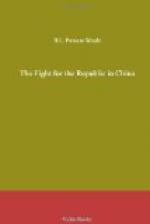5. Clause 5 of Tibetan claims can be discussed.
6. Revision of Trade Regulations of 1893 and 1908, if found necessary, must be made by all the parties concerned.
7. In regard to the limits of Tibet China claims Giamda and all the places east of it.
THE BOUNDARY DEADLOCK
The British plenipotentiary sustained in the main the Tibetan view concerning the limits of Tibet. He suggested the creation of Inner and Outer Tibet by a line drawn along the Kuenlun Range to the 96th longitude, turning south reaching a point south of the 34th latitude, then in south-easterly direction to Niarong, passing Hokow, Litang, Batang in a western and then southern and southwestern direction to Rima, thus involving the inclusion of Chiamdo in Outer Tibet and the withdrawal of the Chinese garrison stationed there. He proposed that recognition should be accorded to the autonomy of Outer Tibet whilst admitting the right of the Chinese to re-establish such a measure of control in Inner Tibet as would restore and safeguard their historic position there, without in any way infringing the integrity of Tibet as a geographical and political entity. Sir Henry McMahon also submitted to the Conference a draft proposal of the Convention to the plenipotentiaries. After some modification this draft was initialled by the British and Tibetan delegates but the Chinese delegate did not consider himself authorized to do so. Thereupon the British member after making slight concessions in regard to representation in the Chinese Parliament and the boundary in the neighbourhood of Lake Kokonor threatened, in the event of his persisting in his refusal, to eliminate the clause recognizing the suzerainty of China, and ipso facto the privileges appertaining thereto from the draft Convention already initialled by the British and Tibetan plenipotentiaries. In order to save the situation, the Chinese delegate initialled the documents, but on the clear understanding that to initial and to sign were two different things and that to sign he must obtain instructions from his Government.
China, dissatisfied with the suggested division into an Inner and Outer Tibet the boundaries of which would involve the evacuation of those districts actually in Chinese effective occupation and under its administration, though otherwise in accord with the general principles of the draft Convention, declared that the initialled draft was in no way binding upon her and took up the matter with the British Government in London and with its representative in Peking. Protracted negotiations took place thereafter, but, in spite of repeated concessions from the Chinese side in regard to the boundary question, the British Government would not negotiate on any basis other than the initialled convention. On July 3 an Agreement based on the terms of the draft Convention but providing special safe-guards for the interests of Great Britain and Tibet in the event of China continuing to withhold her adherence, was signed between Great Britain and Tibet, not, however, before Mr. Ivan Chen had declared that the Chinese Government would recognize any treaty or similar document that might then or thereafter be signed between Great Britain and Tibet.




